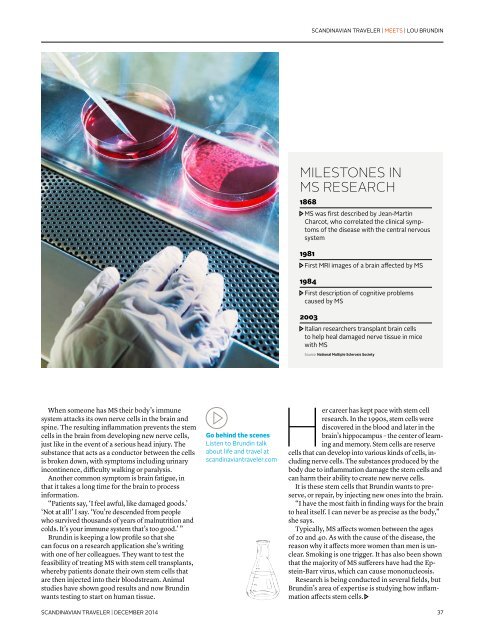st1412_webb
st1412_webb
st1412_webb
Create successful ePaper yourself
Turn your PDF publications into a flip-book with our unique Google optimized e-Paper software.
SCANDINAVIAN TRAVELER | MEETS | LOU BRUNDIN<br />
MILESTONES IN<br />
MS RESEARCH<br />
1868<br />
MS was first described by Jean-Martin<br />
Charcot, who correlated the clinical symptoms<br />
of the disease with the central nervous<br />
system<br />
1981<br />
First MRI images of a brain affected by MS<br />
1984<br />
First description of cognitive problems<br />
caused by MS<br />
2003<br />
Italian researchers transplant brain cells<br />
to help heal damaged nerve tissue in mice<br />
with MS<br />
Source: National Multiple Sclerosis Society<br />
When someone has MS their body’s immune<br />
system attacks its own nerve cells in the brain and<br />
spine. The resulting inflammation prevents the stem<br />
cells in the brain from developing new nerve cells,<br />
just like in the event of a serious head injury. The<br />
substance that acts as a conductor between the cells<br />
is broken down, with symptoms including urinary<br />
incontinence, difficulty walking or paralysis.<br />
Another common symptom is brain fatigue, in<br />
that it takes a long time for the brain to process<br />
information.<br />
“Patients say, ‘I feel awful, like damaged goods.’<br />
‘Not at all!’ I say. ‘You’re descended from people<br />
who survived thousands of years of malnutrition and<br />
colds. It’s your immune system that’s too good.’ ”<br />
Brundin is keeping a low profile so that she<br />
can focus on a research application she’s writing<br />
with one of her colleagues. They want to test the<br />
feasibility of treating MS with stem cell transplants,<br />
whereby patients donate their own stem cells that<br />
are then injected into their bloodstream. Animal<br />
studies have shown good results and now Brundin<br />
wants testing to start on human tissue.<br />
SCANDINAVIAN TRAVELER | DECEMBER 2014<br />
Go behind the scenes<br />
Listen to Brundin talk<br />
about life and travel at<br />
scandinaviantraveler.com<br />
H<br />
er career has kept pace with stem cell<br />
research. In the 1990s, stem cells were<br />
discovered in the blood and later in the<br />
brain’s hippocampus – the center of learning<br />
and memory. Stem cells are reserve<br />
cells that can develop into various kinds of cells, including<br />
nerve cells. The substances produced by the<br />
body due to inflammation damage the stem cells and<br />
can harm their ability to create new nerve cells.<br />
It is these stem cells that Brundin wants to preserve,<br />
or repair, by injecting new ones into the brain.<br />
“I have the most faith in finding ways for the brain<br />
to heal itself. I can never be as precise as the body,”<br />
she says.<br />
Typically, MS affects women between the ages<br />
of 20 and 40. As with the cause of the disease, the<br />
reason why it affects more women than men is unclear.<br />
Smoking is one trigger. It has also been shown<br />
that the majority of MS sufferers have had the Epstein-Barr<br />
virus, which can cause mononucleosis.<br />
Research is being conducted in several fields, but<br />
Brundin’s area of expertise is studying how inflammation<br />
affects stem cells.<br />
37



